
SURROUNDINGS
BOYOLALI
This regency
is located in the middle of Yogyakarta, Solo and Semarang, east of Merapi
and Merbabu Mountains. The city of Boyolali is located 55 Km northeast
of Yogya, 27 km northwest of Solo and 75 km south of Semarang.
Boyolali regency is proud to have the Adisumarmo - Solo International
Airport in its territory, the newly Haj dormitory in the village of
Donohudan is also situated in this regency. This fertile regency has been
known since a longtime as a potential supplier of fresh milk to the biggest
canned milk manufacturers in the country.

Selo
This cool green place located 20 Km westward of the city, on the north
slope of Merapi and the south slope of Merbabu is a check
point for Merapi and Merbabu climbers. There are nice inns and hotels
in Selo for accommodation. This place was a famous holiday resort of Surakarta
Royal Families.
Pengging
Located 10 km west of Solo Airport in the district of Banyudono. There
are several springs here, the one called Umbul Pengging has been
built as a recreational park.
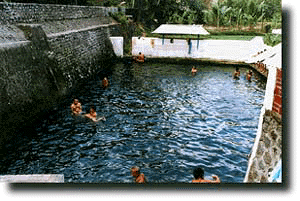
Umbul Sungsang
The graveyard
of Yosodipuro, one of the famous poets of Karaton Surakarta which
attracts some pilgrims is also in this village. The spring nearby the mosque
of the graveyard is considered of having holy water.
Pengging is also a place with magical value. Some believe it was the site
of Ki Ageng Pengging or Adipati/Viceroy Handayaningrat at
the end period of Majapahit Kingdom. He was the grand father of Sultan
Hadiwijoyo of Pajang Kingdom. Thus all the kings/ rulers of Mataram,
Yogya and Solo palaces are direct descendants of Pengging.
Kedung Ombo
Dam
This gigantic dam in Kemusu district is potential for rice irrigation,
at the sametime serves as tourist attraction.
Cengklik
Dam
Located 3 km west of Solo Airport. It is being prepared for recreational
site.
Umbul Tlatar
It is the spring of Tlatar, located north of Boyolali City. There is
a swimming pool and fishing ponds.
Copper Craft
Center in Tumang Cepogo
The villagers who live in this mountainous place, located between Boyolali
and Magelang are born craftsmen of several copper products such as flowerpots,
lampshade, relief, etc.
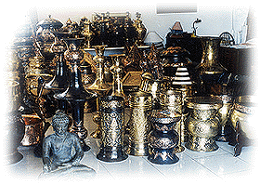 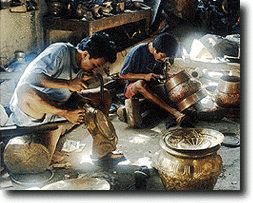
Export Products
Textile and Kenanga oil of Boyolali have a good domestic and foreign
market.
Important
Address
The office of the Regent (Bupati) of Boyolali is at 48, Jl. Merbabu,
Boyolali.
WONOGIRI
Wonogiri is
located on the limestone hills Gunung Sewu around 30 Km south of Solo.
The success of 'Greening Program' by planting productive trees has made
this hilly region looked green.
Selogiri
Monument
Selogiri is a sub-district, which keeps several heirlooms of Puro
Mangkunagaran in a seven meters high tower in the Village of Nglaroh.
Click
here for the related article !
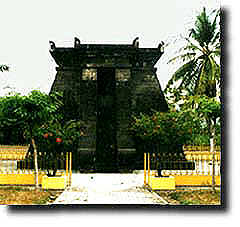
Selogiri Monument
Padepokan
Pak Bei Tani
"The house of Father Farmer" is a renovated house where the
present President Suharto lived as a youngster. It is in sub-district of
Wuryantoro.
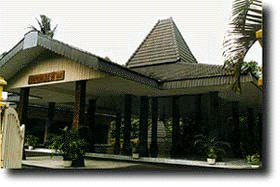
Padepokan Pak Bei
Tani
The Gajah
Mungkur Dam
This Gigantic picturesque dam is located around 3 km from the town
of Wonogiri. The water supply of the dam is from the river - Bengawan
Solo, the longest river in Java.
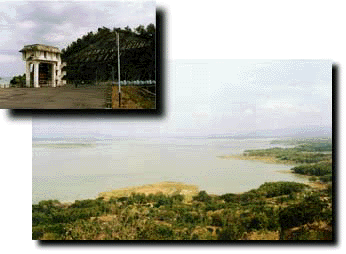
Gajah Mungkur Dam
Its construction
was in 1975 until 1981. The lake of the dam covers an area of 8.800 ha
and has capacity to irrigate 23.600 ha of rice fields in the regencies
of Klaten, Sukoharjo, Karanganyar and Sragen. It supplies the drinking
water for Wonogiri and electrical turbine with capacity of 12,4 M.W.
This is also a beautiful place for water recreation. There is a
pier for boots to take people around the lake and also available facilities
for water skiing, fishing and floating restaurant. The hand-gliding
sport can be enjoyed here.
Dlepih Kahyangan
Located 30 Km southeast of Wonogiri. It is a place for supernatural
tourism. The story date back in the 16th century, when the young Sutowijoto
meditated to acquire divine revelation to become King of Mataram. He was
successful and crowned as the first ruler of Mataram Kingdom II.
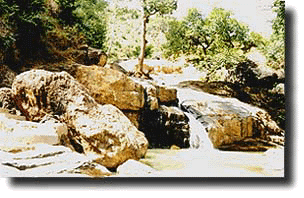
Dlepih Kahyangan
Karang Gupito
Beach
The beach is on the Indian Ocean where the labuhan (sea-offerings)
is held yearly in the Javanese month of Suro. There is a big boulder locally
called Watu Semar (stone of Semar).
Jamu - The
Herbal Medicine
The people of Wonogiri consume a lot of jamu to keep their health.
Many local women sell the jamu, roaming the streets. There is a big 'jamu'
manufacturer in this small town.
Bus Companies
Due to its non-fertile lands, many people of Wonogiri seek their fortune
outside their region, in the big cities of Java, especially in Jakarta.
As a result thereof, some local entrepreneurs have born as owners of bus
companies and some of the buses are luxurious. The regency receives considerable
income from their 'migrants'.
KARANG
ANYAR
This regency
is just east of the city of Solo, its capital is 14 km from Solo. In the
eastern border stands the silent 3265 M Gunung Lawu, hiding a lot of mystical
things.
A big part of this region is a fertile cultivation land where the river
Bengawan Solo passes through.
Gunung Lawu
This Gunung or Mountain Lawu is already famous since the ancient time.
Its previous name was Wukir Mahendra. Some believe the top of the
mountain was the first site of kingdom on the island. The dwellers were
gods descending from Kahyangan (heaven). The gods had seen an empty beautiful
place with similar picturesque panorama and environment like in paradise.
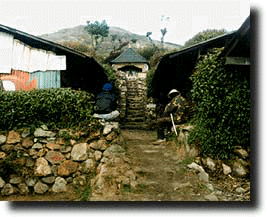
The Top of Mount
Lawu
The second significant
things occurred during the declining period of Majapahit Kingdom when King
Brawijaya V (the last king) made his last spiritual journey in this
mountain. Accompanied by his most loyal servants, he returned to where
he come from (MOKSA - pass away with the body also disappears). Several
places in Lawu are considered sacred by the meditators, such as:
- Temples of
Sukuh and Ceto
- Sendang (spring)
Drajad; Cakrasurya and Cemoro Sewu, Sumur (well) Jalatunda.
- Three spots
on the top; Hargo Dalem, Hargo Dumilah and Hargo Dumiling.
Sukuh Temple
The Sukuh temple is located in the Village of Berjo, Sub-district of
Argoyoso, in the slope of Gunung Lawu 35 Km east of Solo at a height about
910 m above sea level. The temple stretches from the east to the west with
the main gate in the west. This kind of construction is common in prehistoric
time, especially in the meghalitic era of pundan berundak (terrace grave).
The temple consist of three terraces, the first terrace is the lowest level,
followed by the second and the third above it. The terrace are connected
with stairs to each other, each of it has an entrance gate.
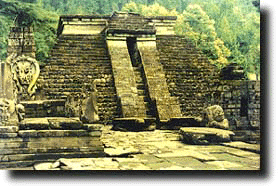
Sukuh temple
The temple is believed
to be constructed in the 15th century during the declining years of Majapahit
Empire. The reliefs found beside the first gate are believed had mean (sengkalan)
reads Gapura Buta Aban Wong and Gapura Buta Anahut Bubut,
meaning the year of 1359 saka or 1437 AD
The remnants of Sukuh Temple consist of :
- Reliefs describe
the union of the symbolic male and female sex organs (fertility symbol).
It can be found on the gate at the first terrace.
- Reliefs describe
the Sudhamala and Garuda Stories.
- Reliefs describe
the hand made iron (Pandai Besi) activities.
- Human statues
- Animal statues
- The main temple
is pyramidal
The temple was
first discovered in 1815 in a very poor condition by Johnson, the
resident of Surakarta, during the period of Raffles government. The first
study in 1842 had done under the leadership of Dr. Van de Vlis,
Hoepermans and was studied by Verbeek in 1889, and finally
by Knebel in 1910.
In 1917 there had been an effort to secure and rescue by the office of
prehistoric sites of the Netherlands East Indian Government, Then in 1989
the restoration was resumed by the Restoration and Maintenance of Prehistoric
and Historic Project in Central Java.
The view surrounding the temple is alluring. The road to this temple with
impressive grandeur is surfaced all the way. The structure and the mood
of the Lawu Temples is different from other temples in Java, it is built
like a Maya stepped pyramid, so it is worth seeing.
Ceto Temple
Further 500 M up the slope of Gunung Lawu, Candi Ceto with numerous
terraces dates from the era of Sukuh. It is another 'erotic' temple
of Java. On the ground laid a lingga decorated with a dragon, lizards,
crab and anchor, behind it is a stone turtle.

Ceto temple
On the top of the temple,
small shrines house a dewa/ god statue and a lingga. The villagers live
in surrounding are Hindus, there is a Hindu Pura in the Village. it is
worth to notice that Lawu Temples still have many questions that remain unreplied.
Who were really the builders, what are the meaning of the reliefs and the
statues?
Tawangmangu
A cool splendid hill resort also on the slope of Gunung Lawu, at a
height of about 1400 M above sea level. The road from Solo via Karangpandan
is a fine trip thru magnificent green terraced hills.
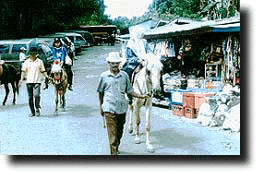
Tawangmangu Park
Tawangmangu
has all kind of facilities, hotel, camping ground, forest tourism, etc.
The climate is fresh and one can enjoy the beautiful scenery.
Grojogan
Sewu
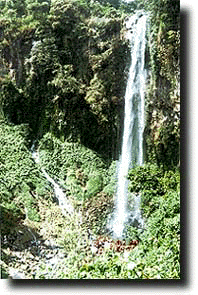 |
It
is a 100 M high waterfall, the pool at the bottom has a very chilly water.
In front of the gate to Grojogan Sewu, horses for rent are available to
ride around Tawangmangu.
Grojogan Sewu/Sewu
Fall
|
Astana Mangadeg
Located in Karangpandan, the main road from Solo to Tawangmangu, turn
southward, it is about 5 Km - here stands the burial hill of Mangkunagaran
court families, in their former territory.
Astana Giri
Bangun
Nearby the Mangadeg, there is another solemn and beautiful graveyard
by the name of Giri Bangun meant for final resting-place for second President Bapak Suharto's
family. The late Madame
Tien Suharto is resting here.
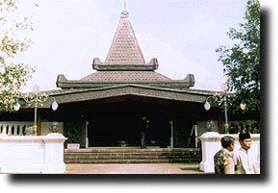
Astana Giri Bangun
Economic
Development
Karanganyar is economically potential, some companies are export-oriented,
dealing in various products. The tourism industry in the slope of Lawu
is still promising.
Karanganyar
Development Corporation
To further develop the economy, the Regional Administration of Karanganyar
cooperating with a private company has established a Karanganyar Development
Corporation.
Click here to get the complete information of Karanganyar Development
Corporation!
SRAGEN
The capital
city of Sragen Regency is Sragen, located around 30 Km northeast of Solo.
The eastern border of Sragen is East Java Province. The famous river, Bengawan
Solo also flows through the fertile rice fields of this region.
Sangiran
It is a village located 17 Km north of Solo, on the road to Purwodadi.
It is an important place for Pithecanthropus Erectus, the pre-historic
Java Man. The Pleistocene Museum keeps some skills of the erectus, fossils
of plants and animals.
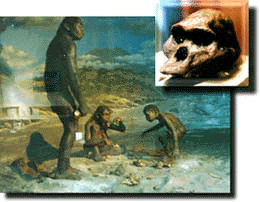
Homo Soloensis (Pithecanthropus
Erectus)
Sangiran and
other places such as Wajak (near Tulungangung) and Trinil
(near Ngawi) are significant places for human evolution/theory.
It is interesting place for scientific tourism in the field of geology,
anthropology and archeology. Many experts came to this site to do some
research and study among other; Van Es (1939), Duyfyes (1936), Van Bemmelen
(1937), Van Koeningswald (1938), Sartono (1960), Suradi (1962) and Otto
Sudarmaji (1976).
Van Koeningswald said that more than five different types of hominoid fossils
have been found in Sangiran, it was incredible. There is no other place
in the world like Sangiran. The Sangiran fossils are very various, they
were earth as well as sea fossils. There was a possibility that island
of Java was erected from the bottom of sea million years ago.
Nowadays, the villagers of Sangiran are making souvenirs from stones such
as statues, axes, eggs, rings, etc to promote tourism.
Gunung Kemukus
It is a hill 25 Km north of Solo, on the top of the hill is said to
be the grave of Pangeran (prince) Samodra and Dewi Ontrowulan.
This site draws a lot of pilgrims wishing to get a fast fortune.
Village of
Butuh
The graveyard of Ki Ageng Butuh located nearby Begawan Solo,
northeast of Solo. Joko Tingkir or Sultan Hadiwijaya the King of Pajang
was also buried here. This sacred site draws also a lot of pilgrims on
certain days.
Ngawut
In this vicinity there are Hot Springs in Ngawut.
Economy
The town of Sragen is located on the road connecting Solo and East
Java. The road is very potential for the smooth transportation of goods
between the two areas. It is one of economic advantages for Sragen development.
A modern plant producing chemical stuffs for textile industry has been
erected on the main Solo – East Java Road.
KLATEN
The capital
of Klaten Regency is located strategically between Yogyakarta and Solo.
The vast majority of land in this region is fertile land for cultivation
with a good irrigation system. This advantage give a great opportunity
for Klaten to develop also economically.
Merak Temple
These four shrines have been discovered in 1924. Those remnant date
back to Hindu Javanese period. In the site were found hundreds of stones
under the shady trees. It is located 15 Km from Klaten, north of Gondang
Baru sugar mill.
The Grave
of Sunan Tembayat
This site is around 10 km southwest of Klaten. For those who come from
Yogya, turn right before the city of Klaten, it is about 4 Km from the
main road. Sunan Tembayat was the one of the famous Wali
(Islamic Saint) in Java, who had a close relation with Sunan Kalijaga.
The Grave
of Ronggowarsito
He was a great poet of Karaton Surakarta, considered as the last poet
of the Karaton.
Sugar Museum
The Regency is famous with its products of sugar made from sugar cane.
A sugar museum can be seen in east of Klaten, on the main road to Solo.
Deles
It is a holiday resort on the slope of Mount Merapi, 1.250 M above
the sea level, 25 Km west of Klaten. There are bungalows cater to visitors.
Jimbong
A holiday resort with parks and pools, with a children playground nearby
the city.
Rowo Jombar
It is another holiday resort with parks and pools, with a children
playground, nearby the city.
Jatinom
Located North of Klaten, where the Yoqowiyu traditional ceremony
held yearly in the Javanese month of Sapar.
Economy
Despite its sugar industry and tobacco crops Klaten is also well known
for its traditional textile manufacturing - the Lurik. The center
of lurik is the village of Pedan. There are also some crafts centers of
traditional products, making wayang, wooden furniture, etc.
Recently a casting iron industry is also developing in this region.
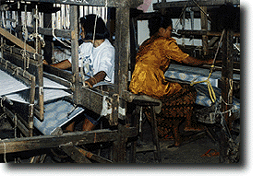
Last but not
least, Klaten since the old days is famous with its Ayam Panggang
(baked-chicken), cooked in a special way with coconut meat - it is very
delicious. It should be developed nation wide as the Yogya, ayam goreng.
SUKOHARJO
This regency
is located south of Solo, in the south borders with Wonogiri and Yogya
in the west with Boyolali and Klaten and in the east with Karanganyar.
The river Bengawan
Solo passes through this fertile region with its proper irrigation system.
Some handicraft
centers and various industry prosperously developing in this regency.
Pasanggrahan
Langenharjo
It is located south of Solo as an cultural heritage of Surakarta palace
dates back 1870. This site is used for recreation and meditation purposes.
Batu Seribu
A tourist resort located at Gentan 14 km south of Sukoharjo, there
are camping and playing ground with swimming pool. Its nice place for relaxing.
Waduk Mulur
It's a dam 4 km south east of the town built in 1926.
The Grave
of Kyai Balak
Located 6 km north east of Sukoharjo. This site draws a lot of pilgrims
in certain days.
Karaton
Kartasura
In the sub-district of Kartasura west of Solo. The ruins of this palace
are still well preserved which attract a number of researches.
Real Estate
Along with the development of Surakarta a modern housing complex with
adequate facilities has been built just south of the City Solo. There are
sport ground, amusement center, schools and shopping complex.
Handicraft
centers
Some places a famous with its handicrafts such as the village Madegondo
6 km from Sukoharjo.
The craftsman skillfully make fascinating partition combining the art of
wooden carving and wayang (leather puppets) making.
Gamelan
Produced in the village of Wirun sub-district of Mojolaban, 5 km east
of Solo. Gamelan is Javanese Traditional music instrument.
Both Sites
are visited by travelers domestic as well as foreign, the product have
been successfully exported to another countries such as Japan, USA, Europe,
Australia, etc.
Industry
This regency is also called "Textile City" due to existence
of some big textile factories.
Other well known products are food stuff, candies, medicine (traditional
jamu and modern), wooden and ratan furniture glass art, agate, batik and
garments, skin handicraft, printing industry, car body manufacturing, plastic
wears, chemical products etc.
Economy
This regency has a potential economic advantage which could be develop
further. In this regard Sukoharjo with its good accommodation and communication
is prepared to invite investors to take part in the economic development
(click the business section for further information).
Suryo S. Negoro

|
